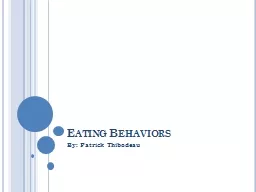

By Patrick Thibodeau Experiment 1 Stressinduced laboratory eating behavior in obese women with binge eating disorder Purpose To compare the eating behavior of obese patients without binge eating disorder versus obese patients with binge eating disorder ID: 395089
Download Presentation The PPT/PDF document "Eating Behaviors" is the property of its rightful owner. Permission is granted to download and print the materials on this web site for personal, non-commercial use only, and to display it on your personal computer provided you do not modify the materials and that you retain all copyright notices contained in the materials. By downloading content from our website, you accept the terms of this agreement.
Slide1
Eating Behaviors
By: Patrick ThibodeauSlide2
Experiment 1: Stress-induced laboratory eating behavior in obese women with binge eating disorder.
Purpose – To compare the eating behavior of obese patients without binge eating disorder versus obese patients with binge eating disorder
Hypothesis
- The
induction of stress has an effect on eating characteristics, especially in women who suffer from binge eating disorder (BED).
71 female subjects – 35 with BED
2x2 factorial designSlide3
Procedure
Both groups (BED and non-BED) fasted overnight.
Upon arrival for the experiment, all participants ate half a sandwich.
After a stressor or neutral event the participants can eat as much pudding as they want.
Trier Social Stress Test versus reading newspaper (neutral).
Behavior was measured using a UEM
Universal eating monitor – special desk equipped with an electronic scale that measures how much food is consumed (g) per .5 seconds.Slide4
Results
BED
enhanced initial eating rate from non-stress to stress
.33 g/s as compared to .53 g/s
Less deceleration of consumption throughout the stress condition than in the non-stress condition
Larger
spoonfuls
Without BED
reduced initial eating rate
.53 g/s versus .47 g/s
Greater deceleration during stress phase than in the non-stress
phaseSlide5
Experiment 2: Understanding variety: Tasting different foods delays satiation.
Purpose – to investigate whether or not variety in tastes of foods delays satiation.
Hypothesis – introduction of different tasting foods to taste and rate during consumption will result in a delayed satiation and greater amount of consumption.
33 participants – 23 females and 10 males
Sex as a between-groups factorSlide6
Procedure
4 lab sessions
Sweet or salted popcorn (preferential)
Participants ate at their own rate, or were interrupted to rate the taste of what they were eating, a similar tasting food, or a different tasting food
.
“eat as much as you like until you feel comfortably full
”Slide7
Results
Women’s consumption did not vary greatly by condition
Men ate more in CC and IC conditions
Conclusion: by giving the participants
a different
food to
taste and rate during the
consumption of the snack, the amount of food eaten was increased in comparison to tasting, eating, and rating the same food.Slide8
Results Continued